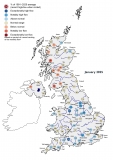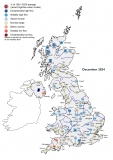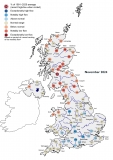Submitted by Steve Turner on
April was an exceptionally dry month dominated by high pressure with few notable rainfall events. Most of the UK recorded less than half the average rainfall, and some parts of southern England and eastern Scotland registered less than a fifth. For the UK overall, April was the equal ninth driest in a series from 1910, the culmination of a period of rainfall deficits that have accrued since summer 2016. The Southern region of England registered its driest July–April in a series from 1910. With minimal rainfall, soil moisture deficits (SMDs) increased rapidly. For the Forth region, end of April SMDs were the third highest in a series from 1961 and highest since 1980. Following prolonged river flow recessions throughout the month, daily flows in some catchments approached or eclipsed late April minima. River flows were substantially below average for most of the UK, with notably low flows in Northern Ireland, eastern Scotland and south-east England. April outflows from the English Lowlands were the fourth lowest in a series from 1961, only surpassed by the notable drought years of 1976, 1997 and 2011. Groundwater levels stabilised or followed their seasonal recessions at the majority of index sites and remained at or below normal everywhere except south-west Scotland and north-east England. Reservoir stocks fell in April, substantially so in some impoundments in northern England, and although most remained only moderately below average there were some notable shortfalls (e.g. 18% below normal at Bewl). Reservoir storage in the Northumbrian region and for Scotland overall was only marginally above previous April minima in series from 1988, though reservoir stocks remain relatively healthy overall. The prospects for the summer are likely to include above normal SMDs and low river flows causing agricultural stress and exerting pressure on the aquatic environment. Low flows are particularly likely in groundwater-influenced catchments of south-east England, some of which have already experienced a contraction of the stream network. Extensive water supply restrictions are unlikely this year; although localised water resource pressure cannot be ruled out, this is dependent on the amount of rainfall in future months for which there is no strong signal.
Read the full Summary here.



